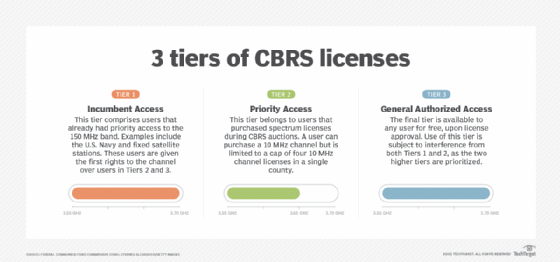
Getty Images
Private LTE vs. Wi-Fi: What's the difference?
Enterprises have a lot of options when designing networks for specialized uses. Wi-Fi supports high-volume environments, but private LTE also provides important benefits.
Private networks have been designed and implemented for a wide variety of uses. Some communicate with people -- either employees or customers or both. Others support IoT networks and communicate with devices.
Regardless of the requirements, enterprises can choose how they want to support these networks. Wi-Fi, for example, is a good answer for environments with devices that require a high volume of data and quick responses. Private LTE is a newer option that can also support these types of devices. Its data rate is greater than 3G but does not meet the 4G standard.
Let's look at private LTE versus Wi-Fi and see how they differ.
Private LTE
Private LTE is a cell service that operates on private bandwidth, thus eliminating delay due to congestion from other users. It supports the same types of users as Wi-Fi, including both people and devices. Like public cell service, it supports larger geographical areas and is broadcast from cell towers.
Private LTE bandwidth can be purchased from the federal government or rented from a mobile communications company. Necessary equipment can be purchased or rented. It's also possible to rent private network service, which eliminates the need to maintain an internal support staff.
Another option to obtain private bandwidth is through Citizens Broadband Radio Service (CBRS). CBRS was originally reserved for the U.S. Navy, and the Federal Communications Commission (FCC) made it available for auction in 2020. CBRS is located in the 3,550 MHz to 3,700 MHz band.
Access is regulated by the three following priority levels:
- Incumbent Access. This is available to the U.S. Navy. The full 150 MHz is available, but the Navy does not use all this bandwidth.
- Priority Access. To obtain this level of service, users purchase via auction a 10 MHz, 10-year renewable band for use exclusively at a single location.
- General Authorized Access (GAA). Users are granted a 100 MHz band at no cost, with access granted within a limited geographical area.
GAA CBRS bandwidth is shared, with access granted by a spectrum access system (SAS). A SAS is a cloud-based system licensed by the FCC to manage bandwidth within the CBRS band. Before becoming active, a system must contact an SAS to request access. A SAS remains in contact with all active systems and monitors all the bandwidth in use to allocate bandwidth to the system requesting access. This process helps prevent interference from other active systems.
LTE networks use SIM cards to control access, unlike Wi-Fi, where access is controlled by a password shared across the network. Each SIM card records data about the specific system and user to ensure data intended for a specific device reaches that device.

Wi-Fi
Wi-Fi networks can be built using even the earliest versions of the technology. Each successive generation has delivered higher data rates to individual systems and a higher aggregate volume to all systems. The most recent versions are Wi-Fi 5, Wi-Fi 6 and Wi-Fi 6E.
Wi-Fi 5
Wi-Fi 5 was introduced in 2014 and supports only the 5 GHz band. It delivers approximately 500 Mbps to an individual system, such as a computer or mobile unit, and delivers approximately 1 Gbps to multiple systems.
Wi-Fi 6
Wi-Fi 6 was introduced in 2019 and supports both the 2.4 GHz and 5 GHz bands. It delivers approximately 750 Mbps to an individual system and 3 Gbps to multiple systems.
Wi-Fi 6E
Wi-Fi 6E was introduced in 2020 and operates on the 6 GHz band. Its data rate can extend nearly 2 Gbps to a single system and approximately 3.9 Gbps in aggregate.
The higher frequency bands are less crowded, but they are more affected by walls and furniture. As a result, signals are strongest when systems aren't blocked from an access point (AP). Higher frequency signals are also less able to penetrate brick, concrete or stone. The lower frequency 2.4 GHz band is more crowded but is able to diffract around obstructions.
All these Wi-Fi generations can support beamforming, through which the AP uses multiple antennas to sense the direction of a system from its returned signals. It then points transmitted signals directly at the system. Signal strength is directly concentrated rather than spread across an area, resulting in further reach and potency at greater distances.
Deciding between private LTE and Wi-Fi
Understanding private LTE versus Wi-Fi depends on different variables. Some applications -- primarily networks located in a single facility or a large campus -- can be built using either Wi-Fi or private LTE. Wi-Fi might be less expensive for smaller areas. But private LTE is often more appropriate for larger areas. Renting or buying bandwidth can raise the price, but if shared bandwidth is sufficient, CBRS might provide an excellent option. In any case, it's important that network designers evaluate their organizational requirements to determine which technology best suits their specific needs.
David Jacobs has more than 30 years of networking industry experience. He has managed leading-edge software development projects and consulted for Fortune 500 companies, as well as software startups.






